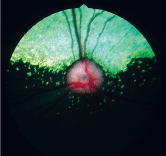Using gene therapy, investigators from the Scheie Eye Institute in Philadelphia, and from other centers in the United States and Italy, improved visionfrom detecting hand motion to reading lines on the Snellen chartin three young adults with Lebers congenital amaurosis (LCA).1
The results of the trial, and a similar three-patient gene therapy trial conducted in
Patients involved in each of the studies had a particular form of LCA, which is characterized by a mutation in the RPE65 gene. This mutation stops the gene from producing a protein necessary for the development of the retinal pigment epithelium. Without the protein, the retina cant process light and convert it to vision.

The researchers who restored vision in humans also restored vision in dog eyes with the same mutation (shown here).
Courtesy: G. Aguirre; Cornell University, (c) Cornell University.
In the trial, investigators used a viral vector to carry a normal version of the RPE65 gene, which was administered by subretinal injection into one eye of each patient.
By two weeks post-op, all three patients reported improved vision in the injected eye. In addition, each injected eye became approximately three times more sensitive to light, as measured by pupillometry, and each was improved compared to the uninjected, previously better-functioning eye.
Patients also acheived significant improvements in visual acuity. For example, one patient improved from hand-motion recognition to a Snellen equivalent of 20/710.
The patients also had less nystagmus, and one patient even experienced better vision in the uninjected eye. The reduced nystagmus benefited both eyes, the researchers say.
The current clinical trial will continue with more patients and with ongoing follow-up to monitor results, says Jean Bennett, M.D., Ph.D., one of the lead researchers. Dr. Bennett also was part of the team that successfully reversed blindness using gene therapy in dogs affected by the same form of congenital blindness. We expect improvements to be more pronounced if treatment occurs in childhood, before the disease progresses, she says.
These results allow doctors to give many patients hope based on human clinical trials, not conjecture, says medical geneticist Rod Nowakowski, O.D., Ph.D., chief of staff of the University of Alabama School of Optometry.
The modest yet positive results from these two clinical trials open the door to the future of gene therapy for hereditary retinal disease, Dr. Nowakowski says. Admittedly, this is preliminary data and there is much to be done in determining long-term safety, efficacy and duration of effect. But, for the fight against blindness, the future has never looked better.
1. Maguire AM, Simonelli F, Pierce EA, et al. Safety and efficacy of gene transfer for Lebers congenital amaurosis. N Engl J Med 2008 Apr 28; [Epub ahead of print].
2. Bainbridge JWB, Smith AJ, Barker SS, et al. Effect of gene therapy on visual function in Lebers congenital amaurosis. N Engl J Med 2008 Apr 27;[Epub ahead of print].

